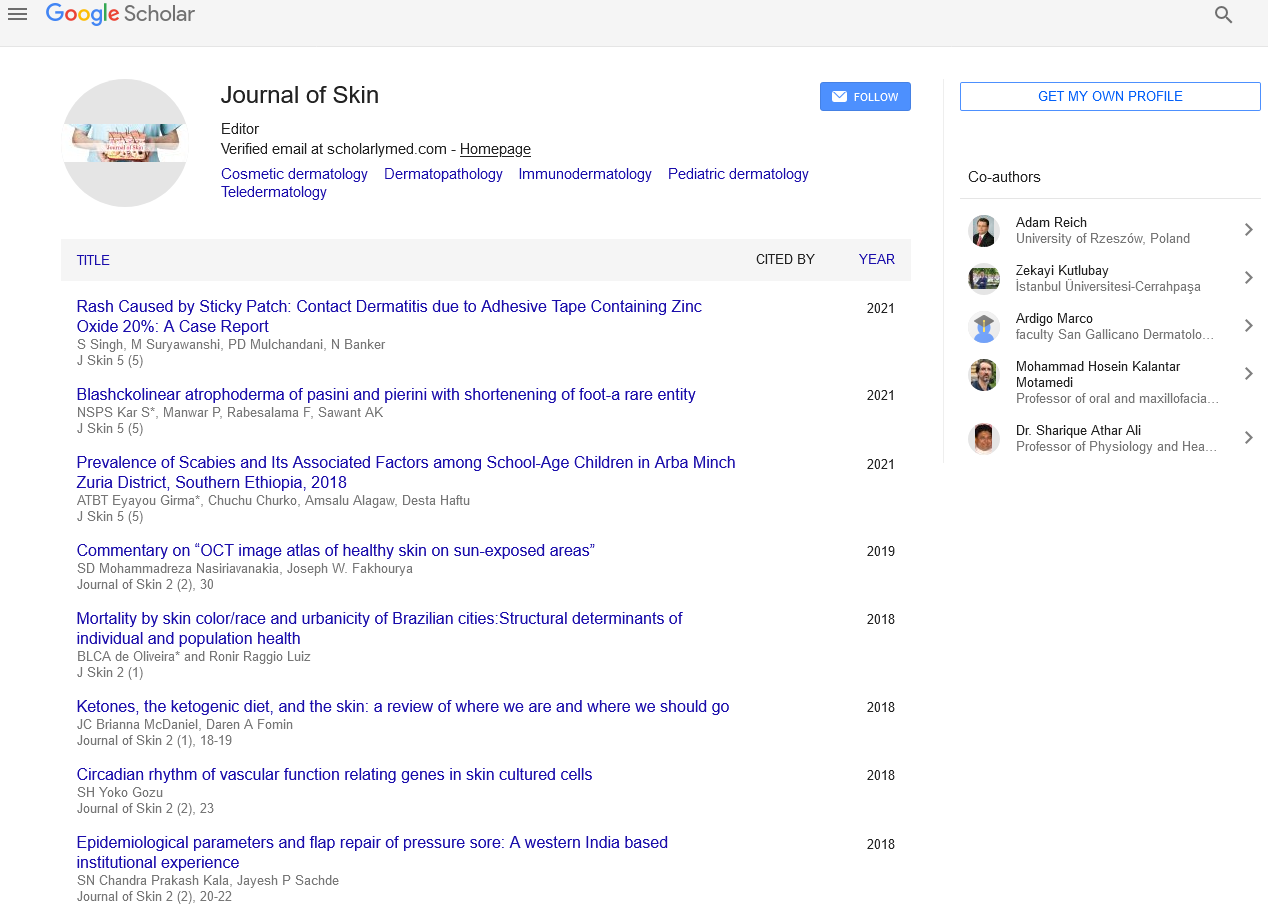Chronic skin condition: Rosacea
Received: 05-Nov-2021 Accepted Date: Nov 19, 2021; Published: 26-Nov-2021
Citation: Yadav V. Chronic skin condition: Rosacea. J Skin. 2021; 5(5):10.
This open-access article is distributed under the terms of the Creative Commons Attribution Non-Commercial License (CC BY-NC) (http://creativecommons.org/licenses/by-nc/4.0/), which permits reuse, distribution and reproduction of the article, provided that the original work is properly cited and the reuse is restricted to noncommercial purposes. For commercial reuse, contact reprints@pulsus.com
Description
Rosacea could be a chronic inflammatory skin condition that sometimes affects the face. Individuals might mistake acne rosacea for skin problems, eczema, or associate allergic skin reaction. The explanation for acne rosacea continues to be unknown, and there's no cure. It causes redness on the jaw, cheeks, and brow. Over time, the redness might become additional intense, taking up a ruddy look, Blood vessels might appear. It's going to conjointly turn out forming pus-filled bumps.
Types
The four kinds of acne rosacea are:
Subtype 1, called Erythematotelangiectatic Acne Rosacea (ETR), is related to facial redness, flushing, and visual blood vessels.
Subtype 2, papulopustular (or skin inflammation) acne rosacea, is identified with skin breaks out, and rarely influences in old women.
Subtype 3, called rhinopathy, could be a rare kind related to the thickening of the skin on your nose. It always affects men and is usually amid to another subtype of acne rosacea.
Subtype 4, is understood as ocular acne rosacea, and its symptoms square measure focused on the attention space.
Symptoms and Identification
The biggest issue that a person can notice is redness on your cheeks, nose, chin, and forehead.
Facial red-faced or flushing: Acne rosacea will cause a persistent red-faced or flushing within the central part of your face. This sign of the condition could also be troublesome to examine on brown and Black skin.
Visible veins: Tiny blood vessels of your nose and cheeks break and appear (spider veins).
Swollen bumps: Many of us with acne rosacea conjointly develop pimples on our face that tally skin problems. These bumps generally contain pus.
Burning sensation: The skin of the affected space might feel hot and tender.
Eye issues: Many of us with acne rosacea conjointly expertise dry, irritated, swollen eyes and eyelids. This can be called ocular acne rosacea. In some individuals, the attention symptoms precede the skin symptoms.
Puffy nose: Over time, skin break out rosacea will thicken the skin on the button, incurring the nose to appear to be bulbous (rhinophyma). This happens extra in men than in women.
There is no trial for acne rosacea. A doctor will create an identification once examining the person’s skin and asking concerning their symptoms and triggers. The presence of enlarged blood vessels can facilitate the doctor distinguish it from different skin conditions. The presence of a rash on the scalp or ears typically indicates a special or synchronal identification. Acne rosacea signs and symptoms occur in the main within the face.
Early identification and prompt treatment will considerably cut back the chance of progression. If the doctor suspects that there could also be associated underlying medical conditions, like lupus, they will order blood tests or refer the person to a medical specialist
Causes and Treatment
The explanation for acne rosacea is unknown. Acne rosacea can be an element of an additional generalized disorder of the blood vessels. The condition is caused by microscopic skin mites, fungus, psychological factors, or a malfunction of the animal tissue below the skin. Though nobody is aware of obviously what causes acne rosacea, some circumstances and conditions will trigger it. There isn't a cure for acne Rosacea; however, treatments will assist you to manage the redness, bumps, and different symptoms.
There are different medications person can take which can minimize the severity of the disease:
Brimonidine (Mirvaso): a gel that tightens blood vessels within the skin to induce obviates a number of your redness.
Azelaic acid: a gel, and froth that clears up knocks, enlarges, and redness.
Metronidazole (Flagyl) and Vibramycin: antibiotics that kill microorganisms on the skin and produce down redness and swelling





